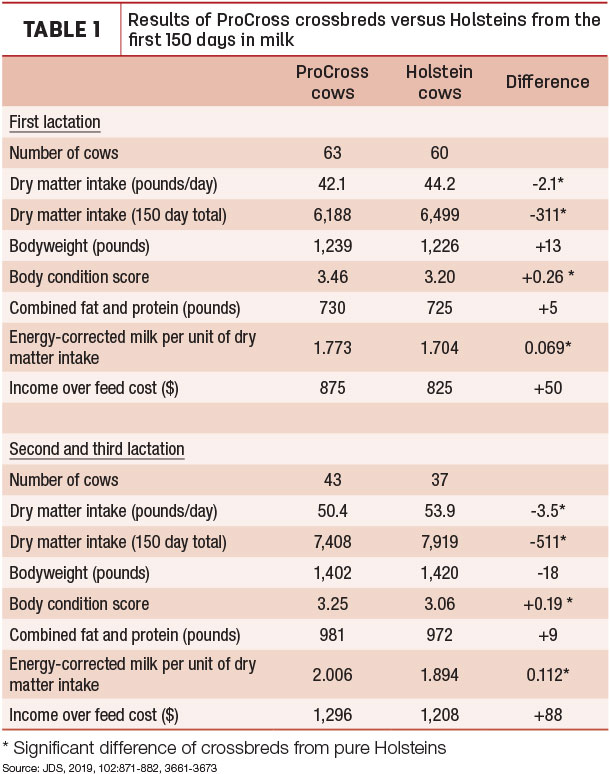Changes in milk pricing towards fat and protein content in milk, reduction of fertility, health and survival of Holstein cows and increase in inbreeding have each contributed to an increased number of crossbred dairy cows in the U.S.
The University of Minnesota began crossbreeding in the 2000s. The initial crossbreds were Jersey × Holstein and Montbéliarde × Holstein and, subsequently, three-breed crossbreds of those breeds. The Jersey breed was later replaced with the Viking Red breed for an ongoing three-breed rotational system of Holstein, Montbéliarde, and Viking Red. Little research has been conducted on the feed intake and feed efficiency of crossbred versus purebred cows.
Collecting data for feed intake of individual cows is costly because of the specialized labor and equipment required. Early feed intake research at the University of Minnesota found that Jersey × Holstein crossbred cows and Montbéliarde × Holstein crossbred cows consumed the same or less dry matter intake compared with Holstein cows but did not differ for fat or protein production. Typically, feed cost accounts for more than one-half of expenses for dairy cattle production. Therefore, our study wanted to compare ProCross crossbred cows with Holstein cows for dry matter intake, production, feed efficiency and income over feed cost during the first 150 days of lactation.
Rotational crossbreeding, usually with three distinct breeds, has grown in global popularity over the past decade. The three-breed rotation of the Holstein, Montbéliarde and Viking Red breeds has growing interest for dairying in temperate climates and is marketed internationally as ProCross by Coopex Montbéliarde (Roulans, France) and Viking Genetics (Randers, Denmark) and in the U.S. by Creative Genetics of California, Inc. (California, U.S.).
The Montbéliarde breed in France has been selected for traits related to production, health and survival, and conformation, while the Montbéliarde breed includes muscularity, which indirectly places a favorable weight on body condition. The Viking Red breed includes the Swedish Red, Finnish Ayrshire and Danish Red; these cows have higher fat and protein content of milk than Holstein cows, and the Viking Red breed has been selected for health and fertility for over 30 years.
Three-breed (Montbéliarde, Viking Red, Holstein) rotational crossbred (ProCross) cows (n=106) were compared to Holstein cows (n=97) for feed intake, production, and body traits during the first 150 days of first lactation. Cows calved in the University of Minnesota St. Paul campus herd from September 2014 to April 2017. A total mixed ration was fed twice daily, and refusals were weighed once daily. All cows were individually fed the same total mixed ration (TMR) on an ad libitum basis. Bodyweight was recorded twice weekly; body condition score (BCS) was evaluated once weekly.
Table 1 has the results of ProCross crossbreds versus Holsteins from the first 150 days in milk.

Crossbred cows consumed less dry matter during the first 150 days of lactation than Holstein cows in both first and later lactations. Combined fat and protein production was not different for crossbred and Holstein cows, but all crossbred groups were numerically higher. Crossbred cows had higher BCS than Holstein cows during the first 150 days of lactation. However, bodyweight was not different between crossbred cows and Holstein cows. Both first-lactation and second- and third-lactation crossbred cows had higher energy-corrected milk per unit of dry matter intake (ECM/DMI) than Holstein cows.
First-lactation crossbred cows had higher income over feed cost during the first 150 days in milk than first-lactation Holstein cows. The $50 advantage of first- lactation crossbred cows over Holstein cows is the equivalent of 34 cents per day, with 6 cents per day from more fat plus protein production and 28 cents per day from lower feed costs than Holstein cows. Second- and third-lactation crossbred cows also had higher income over feed cost than second- and third- lactation Holstein cows.
The $88 difference is the equivalent of 60 cents per day, with 14 cents per day from more combined fat and protein production and 46 cents per day from lower feed cost than Holstein cows. The income over feed cost ignores longevity, fertility and health of cows. Crossbred livestock usually have an advantage over purebreds for fertility and health, accompanied by lower costs for fertility and health disorders, which is another advantage of crossbred dairy cows in addition to their income over feed cost.
During the past decade, interest in crossbreeding has grown for dairy cattle because of the deficiencies of pure Holstein cows for fertility, health and survival. The crossbred cows in this study did not differ from Holstein cows for combined fat and protein production during the first 150 days in milk in their first three lactations. Also, crossbred cows consumed less dry matter intake than Holstein cows. Therefore, the lower dry matter intake of crossbred cows compared with Holstein cows resulted in less feed cost without loss of revenue from combined fat and protein production. The comparison of crossbred and Holstein cows in this study suggests that crossbred cows may have advantages for profitability for commercial milk production. ![]()
PHOTO: A three-breed rotation of Holstein, Montbéliarde and Viking Red produces the ProCross cow, which is shown to have advantages in feed efficiency over purebred Holsteins, according to a recent study. Courtesy photo.
Shonka-Martin, Heins, Hazel and Hansen are with the Department of Animal Science, University of Minnesota – St. Paul.






